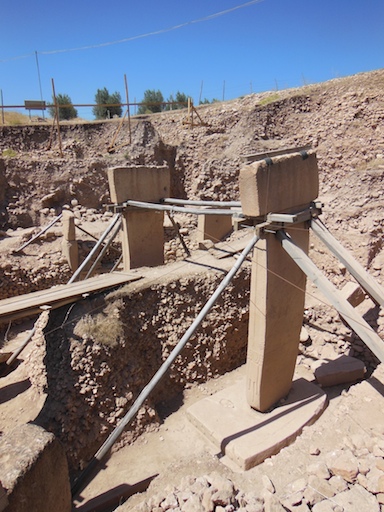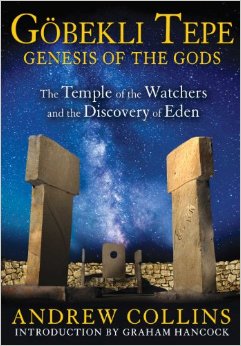
The
twin central pillars of Göbekli Tepe's Enclosure D.
GÖBEKLI TEPE AND THE RISING OF SIRIUS
Andrew COLLINS(1) and Rodney HALE(2)
Abstract: Göbekli Tepe consists of a series of stone enclosures built during the Early Holocene on an isolated mountaintop plateau in southeast Anatolia (Turkish Asia Minor). Speculation has mounted regarding the possible orientation of these monuments with respect to stellar targets, with the rising of Sirius (a CMa A) being proposed as the primary focus of three key monuments-Enclosures B, C & D. The authors demonstrate that such a conclusion is thwart with problems, due to Sirius's faint appearance and unsuitability as a stellar marker during the epoch of construction at Göbekli Tepe.
Key words: Göbekli Tepe, Giulio Magli, archaeoastronomy, Sirius, Orion, Cygnus, atmospheric extinction, aerosols, diurnal arcs, Pre-Pottery Neolithic, Deneb.
1. Author of From the Ashes of Angels (1996), The Cygnus Mystery (2006) and Göbekli Tepe: Genesis of the Gods (2014). 2. Chartered engineer MIET.
Göbekli
Tepe is perhaps the most enigmatic discovery in archaeology for a long time-a
series of megalithic structures constructed primarily by a hunter-gatherer society
who thrived in the northernmost extension of the Fertile Crescent in the Early
Holocene. The stone structures are located in a layered occupational mound (Arabic
tell, Turkish tepe) situated at a height of approximately 780 m above sea level
on an isolated mountain ridge at the western termination of the Ante-Taurus range
(37°13'24.18" N, 38°55'20.85"E), some 15 km northeast of the
city of Sanliurfa in southeast Anatolia.
Excavations under the auspice
of the German Archaeological Institute (DAI) and Museum of Sanliurfa, and headed
by Professor Klaus Schmidt of the University of Heidelberg, have taken place since
1995 and are ongoing today (see Schmidt 2012). An estimated ten percent of the
tell has now been investigated, with four main enclosures and a large number of
other structures being revealed.
Two types of structure are seen, one
evolving from the other. The earliest enclosures, built c. 9500-8500 BC (Layer
III, which corresponds to the Pre-Pottery Neolithic period-PPNA), originally incorporated
twin monoliths with T-shaped terminations set up parallel to each other (see Fig.
1). Around them are in situ circles, or more correctly ellipses, of slightly smaller,
standing stones (1.5-3 m in size), which are generally T-shaped in appearance
and decorated with carved art showing zoomorphic forms and/or anthropomorphic
features. These are arranged in a starburst fashion, their front narrow faces
turned towards the center of the enclosure. They are set in stonewalls, which
often incorporate stone benches (see Fig. 2).
Later
structures, built c. 8500-8000 BC (Layer II, which corresponds to the Pre-Pottery
Neolithic period-PPNB) are rectilinear in form and much smaller in size. They
also contain T-shaped pillars, although here the stones, some of which are decorated,
are reduced in size to no more than 1-1.5 m.
No evidence of domestic activity
has been found at Göbekli Tepe, leading to speculation that it functioned
as a regional centre of cultic activities during the tenth and ninth millennium.
Its final sanctuaries were decommissioned and buried beneath the artificial mound
around c. 8200-8000 BC (Schmidt, 2012).
Fig. 1. Enclosure C showing standing pillars in the perimeter wall. | Astronomical
Targets |
Italian
archaeoastronomer Giulio Magli dismisses Orion as being the target of the monuments
at Göbekli Tepe as it would mean a much younger date for their construction,
i.e. c. 8500-8000 BC, which does not match radiocarbon dating (see below). He
dismisses also alignments towards Cygnus, which although correct, seem unnatural
to what he sees as the natural orientation of the monuments towards the southeast.
Instead, he proposes that the mean azimuths of twin central pillars in three key
enclosures from Layer III-B, C, and D (see Fig. 2)-targeted the rising of Sirius
between the dates 9100-8300 BC (Magli, 2013).
Magli points out that around
9300 BC Sirius began appearing low on the south horizon having been invisible
from the latitude of Göbekli Tepe since c. 15,000 BC. The sight of this new
"guest" star he suggests perhaps motivated the Proto-Neolithic communities
of southeast Turkey to create the monuments of Göbekli Tepe.
| Atmospheric
Extinction It is an intriguing theory, yet one thwart with problems from the outset. The biggest drawback with Sirius's use as a stellar target so soon after its reappearance is that it would have been barely visible to the naked eye, its usual bright magnitude diminished due to atmospheric extinction. This can be calculated using available mathematical formulae regarding the various sources of dimming affecting the apparent brightness of a star-see Schaefer (1993), with a further expansion by Flanders & Creed (2008). Using these formulae we can arrive at a measure of the likely magnitude loss, and therefore the visibility, of a star at any altitude above the horizon at the location of Gobekli Tepe. To achieve this, we must take into account a particularly variable component of the losses involving atmospheric aerosols, such as smoke, dust, moisture, etc, so we use a value representative of what is considered good viewing conditions. A widely accepted figure for the lower limit of human vision of a star is magnitude 6. Yet Schaefer, with good reason, finds that this figure should be magnitude 5.8, therefore we have adopted this value for the point at which a star is just visible. |
|
Using
these methods, we arrive at a mean value for the altitude at which Sirius becomes
visible, which is 0.6°. Thus Sirius would not have been reliably visible at
0.5° altitude, the figure used by Magli to make his calculations. Having said
this, there would undoubtedly have been occasions of better visibility when Sirius
could have been dimly observed at this lower altitude. Yet this rather uncertain
situation is enough on its own to make Sirius an unsuitable object for orientating
such a major building project.
Diurnal arcs
Other factors also have
to be considered regarding the observation of Sirius during the Early Holocene.
The daily rotation of the Earth causes the stars to progress across the sky. In
the case of Sirius, c. 9300-9000 BC, the star skims the southern horizon during
its nightly transit. Yet as it becomes visible to the naked eye we find that for
an increase of altitude above the horizon of half a degree, which occurs across
a period of just 20 minutes, the star swings clockwise towards the south by no
less than 3°.
So to use Sirius at an altitude of 0.5° to establish
an accurate point of orientation, great precision would have been required to
determine the presence of the star where it might or might not have become visible
to the naked eye, a factor dependent on the atmospheric conditions existing at
the time.
Fig. 3. Azimuths against the rising of Sirius at an altitude of 0.5 ° for the epoch 9500-8000 BC. | Mean
Azimuths of Twin Central Pillars Compounding the issues still further are inconsistencies in Magli's calculations of the mean azimuths of the twin central pillars of the monuments in question. His mean azimuths for the twin central pillars of the enclosures, and the dates they target the rising of Sirius at 0.5°, are given as follows: Enclosure D 172° 9100 BC Enclosure C 165° 8750 BC Enclosure B 159° 8300 BC |
For some reason, Magli's mean azimuths for two enclosures-B & D-differ from those suggested by the DAI's own site plan. Moreover, our own calculations suggest additional dating differences to those offered by Magli.
When
these factors are taken into account, a slightly altered set of figures is achieved
using the mean azimuths of the twin central pillars to determine their date of
alignment towards the rising of Sirius at a height of 0.5° (and see Fig. 3):
Enclosure
D 173° 9400 BC
Enclosure C 165° 8950 BC
Enclosure B 157° 8275
BC
In all instances the correlation date between Sirius rising and the
alignment of the pillars has now altered slightly. For instance, in 9400 BC when
the twin pillars of Enclosure D targeted the rising of Sirius, the star was barely
visible to the naked eye across its entire transit of the southern horizon (see
Fig. 4).
By 8950 BC when Enclosure C's twin pillars targeted the rising
of Sirius, the star would still have been faint as it transited the meridian,
due south.
| Around
8275 BC, when the twin central pillars of Enclosure B targeted the rising of Sirius,
the star climbed to make a more appreciable arc, reaching a maximum elevation
of 6° as it crossed the meridian. Despite this encouraging fact, we now come
into massive dating issues. Bone samples taken from Enclosure B have provided radiocarbon dates in the range of 8306-8236 BC (Schmidt and Dietrich, 2010), coincident to the proposed date that its twin central pillars targeted the rising of Sirius. Yet according to the excavators these human remains probably come from intrusive burials made long after the structure's construction (Schmidt and Dietrich, 2010). |
|
Indeed,
Enclosure B is built on the plateau's bedrock immediately south of Enclosure D,
and west of Enclosure C, which are both thought to have been in place by around
9000 BC (Schmidt & Dietrich, 2010). Thus there is every possibility that all
three of these structures, along with Enclosure A, which lies immediately south
of Enclosure B, are roughly contemporaneous. If so, then the twin central pillars
of Enclosure B cannot have targeted the rising of Sirius at the time of their
erection.
Conclusions
Taking
all the evidence into consideration, Sirius's feeble appearance and unsuitability
as a stellar marker during the epoch of construction at Göbekli Tepe makes
it unlikely that the star's reappearance motivated the region's hunter-gathering
society to give up its old lifestyle to construct the first monumental architecture
in human history. For all these reasons the authors reject the proposal that the
twin central pillars in Enclosures B, C & D at Göbekli Tepe were erected
to target the rising of Sirius. They also reject the idea that its enclosures
were oriented towards the southern horizon. Instead, they propose that the true
orientation of the monuments was north, towards the polar region, where the mean
azimuths of two key enclosures-C & D-target the setting of Deneb (a Cygni),
the brightest star in the constellation of Cygnus, in the epoch c. 9400-8900 BC
(see Collins, 2013a, 2013b, and Collins & Hale, 2013).
Bibliography
Collins,
Andrew, "Göbekli Tepe: Its Cosmic Blueprint Revealed", 2013a, http://www.andrewcollins.com/page/articles/Gobekli.htm
Collins,
Andrew, "Göbekli Tepe and the Worship of the Stars",
2013b
http://www.academia.edu/4315208/Collins_Gobekli_Tepe_and_the_Worship_of_the_Stars
Collins,
Andrew, and Rodney Hale, "Göbekli Tepe and the Rebirth of Sirius",
2013, http://www.academia.edu/4315198/Collins_Hale_Gobekli_Tepe_and_the_Rebirth_of_Sirius
Flanders,
Tony, and Phillip J, Creed, "Transparency and Atmospheric Extinction"
Sky and Telescope, 10 June 2008 (October 2013 reprint), http://www.skyandtelescope.com/howto/visualobserving/19712459.html
Magli,
Giulio, "Possible astronomical references in the project of the megalithic
enclosures of Göbekli Tepe", http://arxiv.org/abs/1307.8397
[physics.hist-ph]
Schaefer, Bradley, Universities Space Research Association,
"Astronomy and the Limits of Vision", Vistas in Astronomy 36 (1993),
pp. 311-361
Schoch, Robert, Forgotten Civilization: The Role of Solar Outbursts
in Our Past and Future, Inner Traditions, Rochester, VM, 2012
Schmidt, Klaus,
Göbekli Tepe: A Stone Age Sanctuary in South-East Anatolia, ex oriente e.V.,
Berlin, 2012
Schmidt, Klaus, and Oliver Dietrich, "A Radiocarbon Date
from the Wall Plaster of Enclosure D of Göbekli Tepe" Neo-Lithics 2/10
(2010), 82-83
ARRIVING
MAY 15, 2014
Göbekli
Tepe: Genesis of the Gods
Published by Bear and Company, Rochester,
VM
|
![]()
